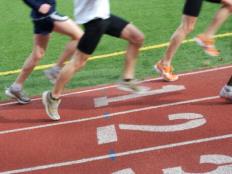Osteoarthritis
While the research is still insufficient regarding any correlation between running and osteoarthritis, the general consensus is that moderate running does not cause osteoarthritis of the knees or hips for healthy people and that running may even protect the joints. However, secondary osteoarthritis is directly associated with a history of joint injuries. These injuries may vary from acute to chronic with pain that is mild or severe. Overuse joint injuries are very common among distance runners. Regularly loading injured joints creates trauma which over time, may "deplete the joint of the lubricating glycoproteins, disrupt the collagen network, slowly wear away the cartilage, and cause numerous microfractures in the underlying bones" (Does Long-Distance Running Cause Osteoarthritis?, by Tyler Childs Cymet, DO and Vladimir Sinkov, MD).
Running while injured can also result in poor body mechanics which leads to chronic injury. All runners must consistently focus on using good form. Women, flat-footed runners, and those with unusually shaped patella undersurface must especially focus on proper running form since they are more likely to develop chondromalacia patella. Maintaining proper form becomes more difficult over longer distances as fatigue and length of running time increases. Heavier runners should be especially mindful of injuries since those with greater body mass show greater evidence of osteoarthritis in the joints. (Hip and pelvis injuries in runners, KH Browning, Physician Sports Med. January 2001; 29:23 –34.)
Other Injuries
In addition to overuse injuries, long distance runners may also experience muscle collapse, blisters, muscle strain, muscle cramps, skin abrasions, exhaustion, and lightheadedness. Most marathon runners experience muscle soreness, but elite marathoners have also experienced gastrointestinal distress and back or joint pain. It has been reported that 29 to 43 percent of marathon runners develop injuries during training. Rate of premarathon injury increases as weekly mileage increases (Just What Does Running a Marathon Do to Your Body?, by Jake Emmett, Ph.D.).
Weight Changes
Many runners train for a marathon to lose weight. Long distance runners must increase caloric intake to maintain the rigorous running schedule. While training, a runner becomes accustomed to eating significantly more carbohydrates. After the marathon has been completed, a period of rest is required for the body to recover. Often, motivation to run has been drained as well since a marathon is so demanding. Running burn-out combined with the habit of eating a high calorie, high carbohydrate diet could cause weight gain similar to that experienced by body builders during the first few weeks after a competition.
Immune System
Running a marathon will temporarily put the immune system into overdrive. As cortisol is released to reduce swelling, the immune system then becomes compromised. Marathoners are encouraged to supplement with vitamin C, reduce outside stressors and get plenty of sleep to support the immune system.
Conclusion
Running generally has profound benefits. It has been shown to decrease the risk of diabetes mellitus, cardiovascular disease, and depression while improving bone density and supporting weight control. However, the risks of marathon distance running must be considered and addressed with proper training, nutrition, rest, and attention to form. Those with heart conditions, biomechanical issues or other risk factors should not begin training for a marathon without close medical supervision. Future articles will provide injury prevention tips and nutritional guidelines for long distance running to help reduce the risks and optimize the benefits of long distance running.
 Sign up for your next race.
Sign up for your next race.Health 101 Examiner Sherri Callery is a fitness junkie who has 25 years of experience with nutrition and physical training techniques.
Examiner.com is the inside source for everything local. Powered by Examiners, the largest pool of knowledgeable and passionate contributors in the world, we provide unique and original content to enhance life in your local city wherever that may be.
- 2
- of
- 2
Get ACTIVE on the Go


Couch to 5K®
The best way to get new runners off the couch and across the finish line of their first 5K.
Available for iOS | Android








Discuss This Article